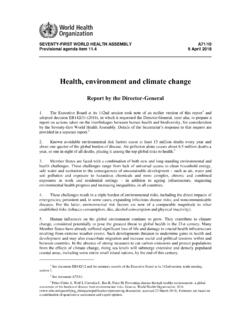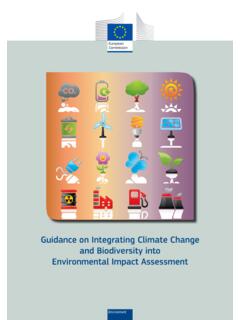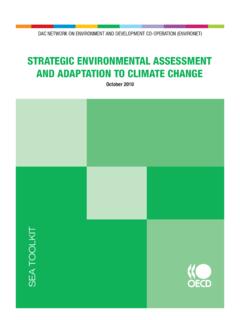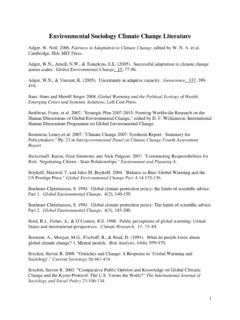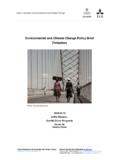Transcription of Public Health 2030: Climate Change and Environmental ...
1 Public Health 2030: Climate Change and Environmental threats and Impacts Driver Forecasts Forecast Summaries Expectable: Changing Climate , vulnerable Health Recurrent heat-related Health problems deliver worst impacts on children, people with asthma, and growing proportion of Americans who are elderly, diabetic, or overweight Droughts, floods, and tornadoes diminish food security, with increasing hunger and worsening nutrition among low- and middle-income families and individuals Severe storms, flooding, and extended rain periods increase contamination of food and water supplies, incidence of gastrointestinal illness, mold and mildew exposure.
2 And sewage overflows Air quality worsens, and injuries and water-, vector-, and insect-borne illnesses spread, particularly in densely populated urban areas Mental Health worsens as emotional trauma and depression spread among Climate refugees and migrants Damaged built infrastructure, roads, and runways lead to more driving accidents, injuries, and deaths Challenging: Runaway Climate , Health emergencies Methane emissions contribute to runaway Climate Change Overwhelming rates of severe heat, disease, asthma, and allergy-related conditions, particularly impacting children, the elderly, the poor, and the uninsured New diseases and antibiotic-resistant bacteria abound Food security diminished as plants and animals die from illnesses, droughts, extreme weather events, wildfires, and hotter summers Severe storms, hurricanes, and floods become the norm by 2024 in many areas.
3 Some small cities and towns become completely uninhabitable Water scarcity, rising food and energy prices, and worsening physical and mental Health yield thefts, black markets, and conflicts within communities for critical resources Forced Environmental migration yields higher rates of disease and violence and widespread intolerance of Climate refugees Aspirational: Changing Climate , Health resilience, and a shift to foresight Collaborative and holistic top-down federal initiatives, bottom-up citizen science and crowdsourcing, and use of foresight for adaptation, mitigation, and prevention yield better Health , Environmental assessment, and policy, successfully reducing severity of expected Climate Change impacts on Health and infrastructure Expanded research and deployment of GMOs, plant and forest biotechnology, and soft geoengineering techniques such as bright water.
4 Crowdsourced Environmental monitoring; geo-tagged Health and Environmental data is continuously provided to social networks and online mapping platforms that use new analytics to identify local factors impeding Health and to point Public Health officials toward innovative solutions Participatory gaming exercises help people prepare for, prevent, and respond to Climate catastrophes, disease outbreaks, and food issues; enactment of zero emissions days and no emissions zones; and heavy investments in urban agriculture Greater transparency around industry practices accelerates adoption of sustainable technologies 1.
5 Public Health 2030: Climate Change and Environmental threats and Impacts Driver Forecasts Driver Background There are growing challenges from Environmental trends, many driven by Climate Change , that will affect Public Health 's roles and activities. The difficult Environmental and weather impacts of Climate Change have already begun to impact how many around the world perceive and enact Public Health and population Health measures. Such Climate events, such as droughts, floods, more intense hurricanes, winter storms, and tornado systems, have already occurred and are expected to grow in intensity and severity.
6 Public Health departments or others will be forced to respond more often; to develop recovery strategies; and possibly take part in national mitigation strategies. The current and future impacts of Climate Change will reshape Public Health and Public Health needs over the next several decades. In recent years, Public Health departments have enhanced their emergency preparedness activities, including Climate related emergencies. Public Health organizations will be challenged to further expand their capacities to deal with Environmental disasters and disease outbreaks.
7 Many regions of the United States will have to respond to (and hopefully are able to mitigate) new Health problems and Environmental conditions that can negatively impact the Health of their populations. The range of potential Climate Change impacts on Health in the United States includes1: Increases in heat-related morbidity and mortality rates Heat-induced difficulties in meeting air quality standards Increases in food-, water-, and vector-borne diseases Increased risks related to diseases originating outside the A prolonged allergy season, which will be particularly hard on the poor, children, and the elderly Extreme weather events (EWEs, droughts, severe storms, and floods) that aggravate conditions, cause hazard-related incidents, and undermine Public Health infrastructure 1.
8 United States. Collaboration among the Department of Agriculture, the Department of Commerce, the Department of Defense, the Department of Energy, the Department of Health & Human Services, the Department of the Interior, the Department of State, the Department of Transportation, the Environmental Protection Agency, the National Aeronautics and Space Administration, the National Science Foundation, the Smithsonian Institution, and the Agency for International Development. Global Change Research Program. Global Climate Change Impacts in the United States 2009 Report.
9 Ed. Thomas R. Carl, Jerry M. Melillo, and Thomas C. Peterson. By David M. Anderson, Donald F. Boesch, Virginia R. Burkett, Lynne M. Carter, Stewart J. Cohen, Nancy B. Grimm, Jerry L. Hatfield, Katharine Hayhoe, Anthony C. Janetos, Jack A. Kaye, Jay H. Lawrimore, James J. McCarthy, A David McGuire, Edward L. Miles, Evan Mills, Jonathan T. Overpeck, Jonathan A. Patz, Roger S. Pulwarty, Benjamin D. Santer, Michael J. Savonis, H. Gerry Schwartz, Jr., Eileen L. Shea, John MR Stone, Bradley H. Udall, John E. Walsh, Michael F. Wehner, Thomas J. Wilbanks, and Donald J. Wuebbles.
10 Global Change Research Program. Web, pp. 89-98. 2. Public Health 2030: Climate Change and Environmental threats and Impacts Driver Forecasts Forecasts Expectable Forecast By 2030, Climate Change has markedly altered the Health and everyday activities of most Americans. Intensifying heat waves have repeatedly set new records for temperatures and heat-related illnesses, stress, and mortality. Diabetics, the elderly, and overweight people have all grown as a proportion of the population since the early 21st century. These groups are highly vulnerable to heat waves and heat stress.
